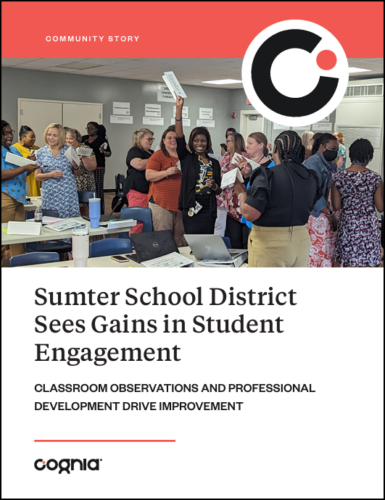The Sumter School District in South Carolina has made significant strides in enhancing student engagement, which has directly contributed to improvements in academic performance. Notably, the percentage of students meeting or exceeding expectations on the SC READY, South Carolina’s statewide summative assessment, has risen dramatically.
According to the South Carolina Department of Education, the percentage of Sumter students meeting or exceeding expectations in English language arts (ELA) increased by 57%, jumping from an average of 24% in 2021 to 37.7% in 2024. In math, the percentage of students meeting or exceeding expectations increased by 45%, climbing from an average of 17.6% to 25.5% during the same period.
This significant growth can be attributed to our data-driven, learner-centric approach to continuous improvement, which has fostered higher levels of student engagement. We’ve established a common language around pedagogical strategies and tailored our professional development to align with student needs. While only in its first year of widespread implementation, this initiative is already yielding impressive results, demonstrating the power of focusing on student engagement in driving academic achievement.
How Sumter’s data-based journey began
Our data initiative is not new; it began during the 2018-19 school year with a soft rollout of a classroom observation tool provided by Cognia. We focused on student engagement because instructional strategies that promote engagement not only enhance student learning but also cultivate a collaborative and dynamic classroom environment. The more effectively teachers can engage students, the more likely they are to retain information and develop critical thinking skills.
We chose the Effective Learning Environments Observation Tool® (eleot®) for its comprehensive approach to evaluating the dynamics of a learner-centered environment. It assesses specific behaviors, attitudes, and actions that play a crucial role in fostering engagement and promoting effective learning experiences across seven domains. For example:
- For equitable learning, learners might engage in differentiated learning opportunities.
- For digital learning, learners might use digital tools and technology to conduct research, solve problems, or create original works.
- For active learning, learners might collaborate on projects, activities, tasks, or other assignments.
- For high expectations, learners might engage in coursework or tasks that require higher-order thinking (e.g., analyzing, applying, evaluating, synthesizing).
- For progress monitoring and feedback, learners might receive feedback from teachers, peers, or other resources for work revisions.
- For supportive learning, learners would have a congenial relationship with their teacher.
- For well-managed learning, learners would follow classroom rules and behavioral expectations.
This observation tool not only highlights strengths within the learning environment but also identifies areas that need improvement.
By utilizing eleot, we hoped to gain insights into how educators interacted with students, how the learning space was utilized, and the overall atmosphere of the educational setting. This observation tool not only highlights strengths within the learning environment but also identifies areas that need improvement, ultimately guiding educators and administrators in their efforts to enhance instructional practices and support student success. Through detailed analysis and ongoing data collection, we continue to create a more effective and inclusive educational experience that prioritizes the needs and well-being of all learners
Initially, we opted for a soft rollout to encourage districtwide buy-in. In 2022, school staff conducted only 393 observations out of 898 teachers across 26 buildings, resulting in an incomplete picture of classroom environments. Nonetheless, this limited number of observations supported our assumption that student engagement should be our focus area for improvement. For instance, in 2022, the average observation score for active learning was 2.73 on a 4.0 scale. These results highlighted a need to equip teachers with strategies to engage students more actively in instruction and explore effective instructional models to create a more engaging learning atmosphere for all students.
Building instructional capacity through data
District leaders realized we could acquire a great deal of useful information if we consistently conducted observations. All schools were on board by the end of the 2023 fall semester. We partnered with Cognia to provide principals, assistant principals, and instructional coaches with a certification course for the observation tool. We also received in-depth professional learning regarding the tool to cultivate our knowledge, expectations, and consistent use.
School administrators schedule observations according to their building’s staff size. For example, a school with one administrator and one teacher per grade level does the minimum requirement: two observations per quarter per teacher. Larger schools conduct observations more frequently.
However, during training, some individuals revealed they weren’t sure what to look for. So, we created training videos featuring Sumter teachers and classrooms exhibiting active learning strategies as demonstrated in the domains the tool examines.
We use observation data to coach new, inexperienced teachers. The data’s focus on learners makes those teachers feel less pressured. We are also using the data to drive professional learning during regularly scheduled professional learning days at both the school and district level.
Increasing data savviness
During the summer of 2024, we provided professional learning to our school leaders about the observation data and how it can be used to inform instructional practices and identify the next steps for improvement. Learning how to triangulate data has helped Sumter educators take a more holistic view of students’ progress.
For example, we analyzed stakeholder surveys to compare students’ responses with our observations using eleot. This helps us identify correlations between student feedback and actual classroom experiences. Furthermore, we also consider state and district assessment data, students’ discipline and attendance records, and student participation in school clubs and after-school organizations to provide deeper insight into their overall engagement in the school community. By employing data protocols and triangulation, we now ensure a comprehensive understanding of student engagement and outcomes, allowing for informed decision-making and targeted improvements specific to our individual schools and the district as a whole.
These protocols help our schools and teams understand that collecting, reviewing, analyzing, and, most importantly, acting on data is a continuous school improvement process.
To continue the momentum, our professional learning and academics teams now hold monthly meetings with school leaders where we examine data findings and relate them to leaders’ progress on their professional learning plans. In our weekly principal update newsletter, we share a running slide deck that prompts principals to review their data or reflect on information shared during a previous data meeting. These protocols help our schools and teams understand that collecting, reviewing, analyzing, and, most importantly, acting on data is a continuous school improvement process.
A solid foundation
In 2023, Sumter conducted 2,700 observations across all our schools. We now have accurate baseline data for moving forward and have started to see the benefits of data-based decision-making.
In addition to our improved performance on end-of-year state assessments in ELA and math, the number of our schools designated as underperforming decreased from 12 schools in 2022 to only seven schools in 2023.
We still have several challenges to overcome, but we’re working to ensure that all Sumter educators understand that success depends on maintaining a continuous cycle of improvement. We’ll build on each accomplishment by celebrating our successes, reflecting on what was learned and working on the next steps for improvement.
Read the full community story.
© Cognia Inc.
This article may be republished or reproduced in accordance with The Source Copyright Policy.
The information in this article is given to the reader with the understanding that neither the author nor Cognia is in engaged in rendering any legal or business advice to the user or general public. The views, thoughts, and opinions expressed in this article belong solely to the author(s), and do not necessarily reflect the official policy or position of Cognia, the author’s employer, organization, or other group or individual.



